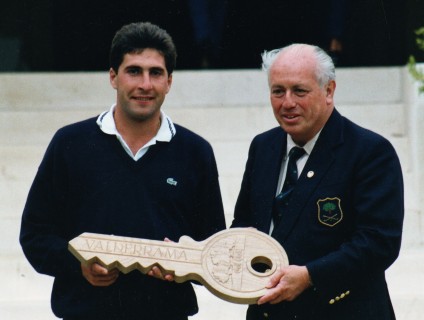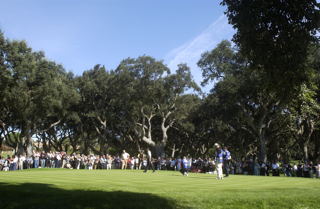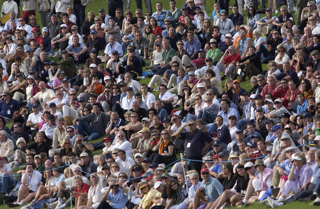The VALDERRAMA Story
1 Oct
European Tour grand finale prelude to Ryder Cup
(Published in The Reporter October 1994)
By ROD NEAL
IT WAS THE EVE of the inaugural Volvo Masters and Jaime Ortiz-Patiño was reflecting on the preceding three years. Early in 1985, not long after he and seven fellow golfers, all friends, had formed a Panamanian company, Valderrama Investments, to buy the former Las Aves (or “Sotogrande New”) golf course, he revealed that the club would host a major competition “with pleasure” if asked by the Spanish Golf Federation.
At the time, the revelation was unexpected, as the popular belief was that Sr Ortiz-Patiño, grandson of Bolivia’s “Tin King” and president of the World Bridge Federation, and his co-founders (including Sir Philip Oppenheimer) wanted to preserve the club’s exclusive image and, in effect, operate it as an elite golfing retreat for friends and close acquaintances.
To some extent, that philosophy prevails even today, but by 1988 it had become clear that Valderrama also was willing, even keen, to display its renowned layout before a wider audience.
So, six years ago, Sr Ortiz-Patiño was radiating enthusiasm as he prepared to welcome the European Tour’s leading players to a new event marking the grand finale of the season, the Volvo Masters.
Asked when, and why, he had decided that the Volvo Masters would be an appropriate championship for Valderrama’s “coming out”, so to speak, his reply was ironic in the light of subsequent events: “I felt it was right that one day we should stage here a great tournament. I was looking for just one big event. The Ryder Cup should come to Continental Europe in 1993, and if it does it should be in Spain that first time. I would have liked, dreamt, to have had something like the Ryder Cup.
“Then last summer, after the (1987) British Open, I was approached and asked informally if I would be interested in hosting a major event.
“I said, yes, a major event, but not a minor one. Volvo came down to speak to me and told me they had decided to create a major new event along the lines of Augusta (venue of the US Masters) which would be the crowning event of the season.”
Though concerned that Valderrama required a further 12 months of fine-tuning before it would be ready, Sr Ortiz-Patiño acceded to Volvo’s representations, and the partnership between the golf course universally considered to be the most impeccably maintained in Europe and the Swedish car-maker that is the multi-million-pound corporate underwriter of the Tour has flourished ever since.
During that same 1988 interview, the Bolivian billionaire, who commutes between homes in Geneva and Sotogrande, declared unequivocally that his plans were confined to just one “major” event. “Valderrama has become synonymous with the Volvo Masters,” he said. “As long as we both get on well – and we get on very well so far – I will have no other championship.”
They still get on well (the original, five-year contract was renewed for at least three additional years); however, subsequent circumstances have modified the latter view.
In spring 1992, declaring himself committed to ensuring Spain was not overlooked again by the Ryder Cup committee (the Cup, held biennially between Europe and the United States, did not, in the end, come to Continental Europe in 1993), the Bolivian billionaire announced Valderrama’s candidacy to host the 1997 matches.
This time, unable to take refuge in the argument that there were no Spanish candidates of adequate calibre, and also influenced by new political considerations, the committee first confirmed Spain as the venue then (earlier this year) chose Valderrama as host.

José María Olazábal receives the “Key to Valderrama” in recognition of his commitment to the Volvo Masters
So where does this leave the Volvo Masters?
Where it is, probably. Even though the logistics of preparing for and staging an event such as the ultra-marketed (and intensively-hyped) Ryder Cup are daunting, it is unlikely a more formidable partnership than Sr Ortiz-Patiño and Valderrama could be found to ensure success…and also to continue to host a barely less significant tournament in the interim.
In the first place, the club co-founder, president and very much hands-on chief executive is also now the sole owner; he bought out his partners in 1990, noting that it freed him to go ahead with an expensive upgrading of the course and clubhouse without having to justify spending other people’s money..
And go ahead he has, at a cost estimated at several million pounds.
His single-minded determination to turn Valderrama into the “Augusta of Europe” was demonstrated back in 1988 when the grounds staff was considering pruning a tree beside the then 18th tee.
No, he instructed. “We leave the branch intact. We’ll lower the tee.”
The alternative cost several thousand pounds but that was irrelevant. “I love those trees and they’ve been there for centuries,” he said later. “They’re much older than we are. By cutting that branch the tree would have lost all its character.
“We take a lot of care with the course, care to maintain the green, the environment, that the players enjoy.”
Not that he has baulked at uprooting other parts of the course.
Ever attentive to complaints and observations by players competing in the Volvo Masters (and there are invariably many of the former as they struggle against one of the more demanding layouts in Europe), he is continually changing the course in order to neutralise criticism.
This is highlighted by his work on the 17th, where the original design by the doyen of golf course architects, Robert Trent Jones, has been radically altered under the supervision of Severiano Ballesteros (and with the approval of Trent Jones) to make it more spectator-friendly: i.e. so more people can see the action without having to hire stilts or periscopes, as inevitably is the case when there are 26,000 spectators following just four match-play groups.
Sr Ortiz-Patiño also has bank-rolled a major refurbishment of the clubhouse, in conjunction with the creation of the finest golf museum in Spain.
Among the collection of classical memorabilia at the museum is an ancient golf club for which he paid £92,400 at a Sotheby’s auction in 1992 (beating the previous world record price for a club by £40,000). Since then he has also paid £16,000 for a 180-year-old Spode bowl, the first known golf trophy.
Clearly, then, Valderrama’s countdown to 1997 is being conducted on both a practical and an aesthetic level, with attention paid not only to the condition and form of the course but also to the peripheral aspects so important to the success of a tournament in the modern era: hospitality amenities; car parking and access; spectator convenience, comfort and control; security.
In the meantime, amidst the euphoria over the election of Valderrama for the Cup matches (among tourism authorities grateful for the incalculable publicity, as well as among local residents marginally less sceptical now about official pledges that the Estepona-Sotogrande dual carriageway will be finished by the end of 1996), the Volvo Masters has tended to be relegated to a secondary role.
To some extent this is understandable.
Though one of the three leading events on the European Tour (together with the British Open and the PGA Championship), and with £750,000 in prize-money (and a £500,000 bonus pool to be shared among the top Order of Merit players for the season, provided they tee up at Valderrama), the Volvo Masters does not exactly ignite widespread enthusiasm among local (or travelling) fans.
Even on the final day, when so much can be at stake (number one honours for the year; for the top players, a place in the next season’s US majors; for the lesser ones, a useful cheque to ease mortgage worries for another year), the number of spectators barely tops 3,000.
This is partly because the weather often turns unpleasant in that part of the Coast at that time of the year (October 27-30 this year, with the pro-am on the preceding Wednesday) and also because of the “distance” (in the view of the less mobile or motivated) of Sotogrande from the more populated parts of the “Costa del Golf” (Marbella, Mijas-Costa, etc.).
For the latter reason, it is quite conceivable that the inaugural Andalucian Open to be held by the Women Professional Golfers’ European Tour at Mijas from November 3-6 will attract greater interest, in spite of being minus many of its own leading players as well as falling well short of the high international profile of the men’s Tour.
Nevertheless, those who do make the trip to Valderrama in October are guaranteed not only the opportunity of seeing Europe’s finest stars – Jose Maria Olazábal, Nick Faldo, Bernhard Langer, Ian Woosnam, Severiano Ballesteros and Sandy Lyle – in action over the exquisitely manicured fairways and greens of Valderrama but also the chance of doing so at relatively close hand.
Though security is, understandably, tight, there is little of the heavy-handed and pompous officiousness prevalent among marshalls at many other events and, especially during the earlier rounds, the lack of spectators enables those present to
If there has been one grey note over the years it has been the unseemly reluctance of some of the leading players to commit to the event.
Though never publicly acknowledged, these players were known to be at odds with Volvo’s rigidly-enforced policy of not paying appearance fees.
Otherwise accustomed to receiving lucrative inducements to ensure their participation in other events, they were unconvinced by the sponsor’s arguments that there was sufficient prize-money on offer, that the top players would almost certainly qualify for a hefty share of the bonus pool (in effect, an “appearance fee”) and that, besides, they owed it to the Tour, Volvo and their colleagues to support the Volvo Masters to ensure maximum media and Press exposure.
Compounding their displeasure was the severe challenge of the course. Why, they and the lesser players asked, should they be put through such an ordeal after a lengthy, arduous season?
Predictably, few spectators and pundits were able to offer much sympathy for their plight, noting that, while the top players were able to flit from tournament to tournament on Concorde or in their private jets, each of the other 54 players qualifying for the Volvo Masters also had won well over £100,000 in prize-money during the year as well as being pampered with courtesy cars, five-star accommodation, on-site physiotherapy and club-repair assistance, etc.
Despite the grumbles, most usually came round to the official view.
In the inaugural tournament, in 1988, only Bernhard Langer was absent as Faldo, Ballesteros, Lyle and Woosnam took the top four places (Olazábal was joint 16th). Faldo’s victory enabled him to pass Olazábal for second place in the final Order of Merit, behind Ballesteros, who already was guaranteed the top spot before teeing off, irrespective of his Volvo Masters finish.
In 1989, in the absence of Ballesteros (claiming fatigue) and Langer again (playing in Japan) Ronan Rafferty not only won the event but also slipped past more fancied opponents to that year’s number one spot. Faldo was second in the tournament, Olazábal (who had been £2,000 ahead of Ulsterman Rafferty going into the event) was third, Lyle fourth and Woosnam joint 12th.
Langer condescended to appear the following year (Ballesteros stayed away again), and finished joint fourth with Olazábal. Woosnam’s share of 21st, with Lyle, sealed him the year-long Order of Merit title as Australian Mike Harwood sneaked through for the tournament title.
It was an Australian double in 1991, when Rodger Davis edged Faldo into second place, with Langer third and Ballesteros (having kissed and made up with officials and entering the event once again secure as the European number one) fourth. Lyle was joint ninth and Olazábal 12th, while it was Woosnam’s turn to take the week off.
In 1992, Faldo didn’t need to finish first, second or anywhere; he had the Order of Merit all tied up (hence the absence of Ballesteros). So his joint 23rd place was irrelevant and left the main interest centred on the identity of the winner. Lyle, on something of a comeback trail, proved a popular champion, beating Colin Montgomerie on the first play-off hole, with Olazábal sixth, Langer eighth and Woosnam 13th.
Last year, Montgomerie “did a Rafferty”. Like the Irishman, not one of the more endearing characters on the Tour and until then not considered one of its more outstanding stars, he nevertheless displayed a superb touch to win the £125,000 first prize cheque and, even more surprisingly, finish atop the Order of Merit for the year. Woosnam finally came to relative terms with Valderrama, finishing fifth, Lyle was 20th and Olazábal and Langer joint 23rd. Ernie Els, the young South African who was to win this year’s US Open, finished equal 10th.
As The Reporter was going to press last month, Montgomerie was cruising to a commanding lead in the money list and could very well have secured a second consecutive number one spot well before the Volvo Masters.
In the tournament’s previous six editions, that would have left only the lesser question of the new champion, but this year is different.
As the official host of the 1997 Ryder Cup rather than merely the favoured candidate (as last year), Valderrama will be taking the centre-stage, with Jaime Ortiz-Patiño under the main spotlight and no doubt reminded of his words before the decision was made back in May:
“The Valderrama club… will spare no efforts or energies to make it an unqualified success,” he vowed.
“It will be our single-minded aim to stage this great event so that it will be a source of pride and satisfaction to…everyone in Europe who loves the noble game of golf.”
The “it” in question was the Ryder Cup, but he could very well have been talking about the Volvo Masters four years before.





No comments yet